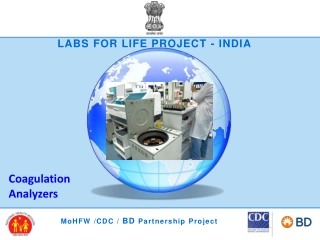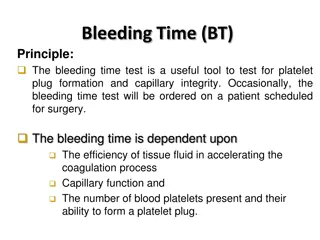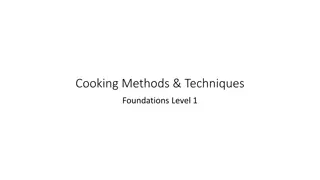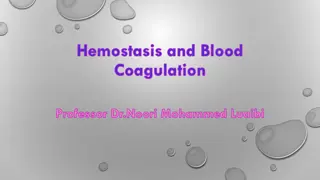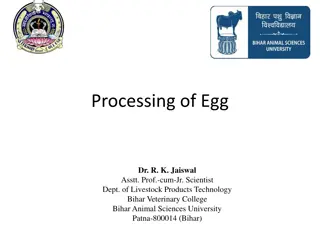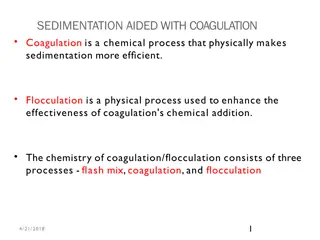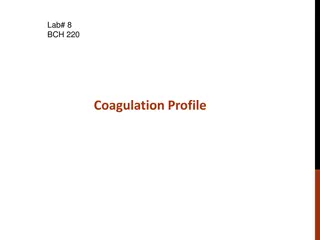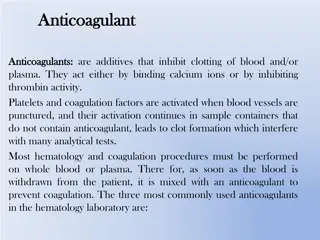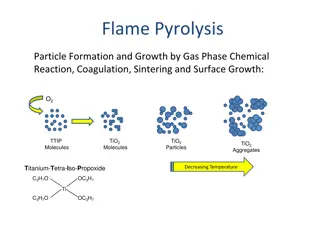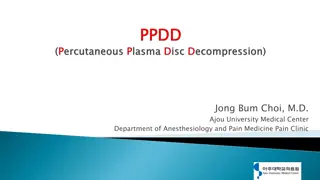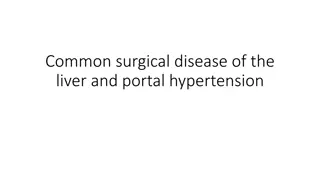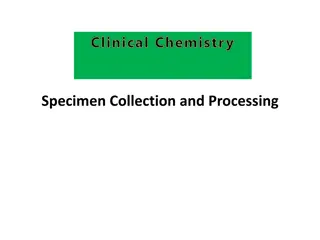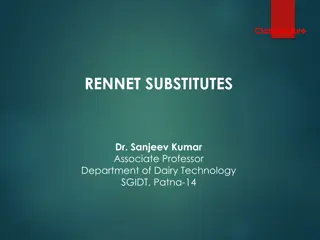Coagulation Analyzers
The current instrumentation used for coagulation analysis in India through the MoHFW/CDC/BD partnership project. Understand the basic principles and various detection methods used in coagulation testing.
0 views • 14 slides
Research Antibodies and Reagents Market
Recombinant Coagulation Factors Market by Type (Factor VIII, Factor IX), Source (CHO, HEK), Application (Hemophilia (Type A, Type B), Others), End User (Hospitals, Clinical Research Laboratories) - Global Forecast to 2030
2 views • 3 slides
In Vitro Diagnostic (IVD) Products Market Size
\u2018Indonesia IVD Market by Product (Kits, Instruments, Software), Technology (Immunoassay, Hematology, Coagulation, Diabetes, Molecular), Application (Infectious Diseases, Cardiology, Oncology), and End User (Hospital, Diagnostic Lab, Home Care) - Forecast to 2029.\u2019\nAccording to this latest
2 views • 4 slides
Understanding Bleeding Time and Coagulation Time Tests
The Bleeding Time (BT) test evaluates platelet plug formation and capillary integrity, crucial for surgery preparations. Prolonged bleeding times indicate low platelet count or dysfunction. The Duke method is one way to determine Bleeding Time. Sources of error, such as medication interference, impr
5 views • 8 slides
Understanding Blood Clotting Factors in the Human Body
Blood clotting factors play a crucial role in the coagulation process to prevent excessive bleeding. Factors such as Fibrinogen (Factor-I), Prothrombin (Factor-II), Thromboplastin (Factor-III), Calcium Ions (Factor-IV), Labile Factor (Factor-V), and Stable Factor (Factor-VII) are essential for the c
7 views • 14 slides
Understanding Coagulation Profile in Hemostasis
Coagulation profile testing is crucial in assessing blood clotting ability. The process of coagulation is essential for hemostasis to prevent bleeding or clotting disorders. This summary explores the steps involved in hemostasis, the clotting cascade, and the triggers for the extrinsic and intrinsic
6 views • 14 slides
Recombinant Coagulation Factors
Explore $24.21 billion Recombinant Coagulation Factors Market: Get exclusive insights on key market trends, segments, geographical analysis, & competitive analysis!\n
2 views • 4 slides
Understanding Calcium Metabolism: A Comprehensive Overview
Calcium metabolism plays a critical role in various bodily functions like nerve conduction, coagulation, and bone mineralization. It involves processes such as calcium absorption, distribution, and homeostasis, regulated by hormones like PTH and calcitriol. The balance of calcium in the body is cruc
7 views • 50 slides
Understanding Cooking Techniques and Their Effects on Food
Cooking methods play a crucial role in transforming food through processes like dry, moist, or combination cooking. Heat transfer methods such as conduction, convection, and radiation influence how food is cooked. Dry cooking techniques use oil or hot air, while moist cooking involves using liquid.
0 views • 9 slides
Understanding Shock and Blood Transfusion in Surgery
Shock is a state of low tissue perfusion leading to metabolic changes like anaerobic metabolism and acidosis. As cellular hypoxia progresses, immune and coagulation responses are activated, impacting cardiovascular, respiratory, renal, and endocrine systems. Shock can be classified into hypovolaemic
0 views • 38 slides
Understanding Coagulants, Anti-Coagulants, and Blood Components in Pharmaceuticals
Mrs. Sashmitha Samuel, an Associate Professor in the Department of Pharmaceutical Chemistry, delves into the importance of coagulants, anti-coagulants, and the components of blood. Blood, a vital fluid in the body, carries nutrients, oxygen, and helps remove waste products. Learn about the process o
1 views • 43 slides
Hemostasis and Blood Coagulation Mechanisms Explained
Hemostasis refers to the prevention of blood loss through vascular constriction, platelet plug formation, blood clotting, and fibrous tissue growth. Vascular constriction occurs immediately after vessel damage, initiated by myogenic spasm, autacoid factors, and nervous reflexes. Platelet plug format
0 views • 25 slides
Overview of Egg Processing and Functional Properties
Egg processing involves the production of various convenience forms of eggs for commercial, food service, and home use, including refrigerated liquid products, frozen products, and dried or specialty products. The process includes washing, breaking, pasteurization, and classification into different
0 views • 11 slides
Understanding Sedimentation Aided with Coagulation and Flocculation
Sedimentation aided with coagulation and flocculation is a chemical and physical process used in water treatment to efficiently remove impurities and particles. Coagulation involves adding chemicals to neutralize particles, while flocculation helps in forming larger clumps for easier removal. The en
0 views • 54 slides
Understanding Coagulation Profile: A Comprehensive Overview
Coagulation is a crucial process in hemostasis that involves clot formation. This profile delves into estimating clotting time, bleeding time, and prothrombin time to assess coagulation status. Explore the mechanisms of hemostasis, clotting cascade, triggers of intrinsic and extrinsic pathways, and
0 views • 12 slides
Understanding Anticoagulants in Laboratory Hematology
Anticoagulants are crucial additives that prevent blood clotting during laboratory procedures. The commonly used anticoagulants include EDTA, sodium citrate, and heparin, each with specific concentrations, modes of action, and color-coded identifications. EDTA is ideal for blood cell counts, sodium
0 views • 6 slides
Flame Pyrolysis: Particle Formation and Growth Mechanisms
Understanding the intricacies of flame pyrolysis for particle formation and growth involving gas phase chemical reactions, coagulation, sintering, and surface growth processes. The method explores the effects of different reactants, temperatures, nozzle quenching, and electric field control on parti
0 views • 53 slides
Ablation Techniques in Medical Practice
Ablation procedures like PPDD and Coagulation are effective methods for treating various conditions such as cardiac arrhythmias, tumors, and wound debridement. RF ablation offers advantages such as precise targeting, lower tissue temperatures, and tissue preservation at the molecular level. Understa
0 views • 33 slides
Overview of Common Surgical Liver Diseases and Portal Hypertension
The liver plays a crucial role in metabolism, coagulation, and immune function. Surgical diseases of the liver, such as liver cysts and cavernous haemangiomas, can impact its normal functions. Imaging modalities like ultrasound (US), CT scans, and MRI are essential for diagnosing and staging liver t
0 views • 46 slides
Understanding Anticoagulants: Mechanisms, Indications, and Limitations
Anticoagulants play a crucial role in preventing blood clotting and are used in various medical conditions such as myocardial infarction and deep venous thrombosis. They include heparin, warfarin, and antiplatelet agents like aspirin. This article explores the mechanisms of action, indications, and
0 views • 29 slides
Clinical Chemistry Specimen Collection and Processing Overview
Clinical chemistry specimen collection involves obtaining blood samples for analysis. Serum and plasma are commonly used specimens, each requiring specific handling. Different anticoagulants like heparin are used to prevent blood clotting during sample processing. Heparin, a widely used anticoagulan
0 views • 15 slides
Exploring Rennet Substitutes in Cheese Making
Discover alternative options to traditional rennet for cheese production, including plant-based enzymes like papain and bromelain, as well as microbial rennet derived from bacteria. Learn about recombinant chymosin and its advantages in cheese making, such as reduced bitterness and predictable coagu
0 views • 6 slides
Understanding High-Frequency Surgery: Applications and Effects
High-frequency (HF) surgery involves the application of electrical energy to induce thermal changes in tissue cells, used for hemostasis, cutting, and sealing in various surgical procedures. The technique prevents undesirable bioelectrical and biothermal effects like the electrolytic and faradic eff
0 views • 25 slides
Water Supply System in Cape Town: Overview and Infrastructure
Cape Town's water supply system, managed by the City of Cape Town's Water and Sanitation Department, serves over 4 million residents. The system relies on raw water from dams and reservoirs, with treatment plants ensuring water quality through processes like coagulation and disinfection. The distrib
0 views • 10 slides
